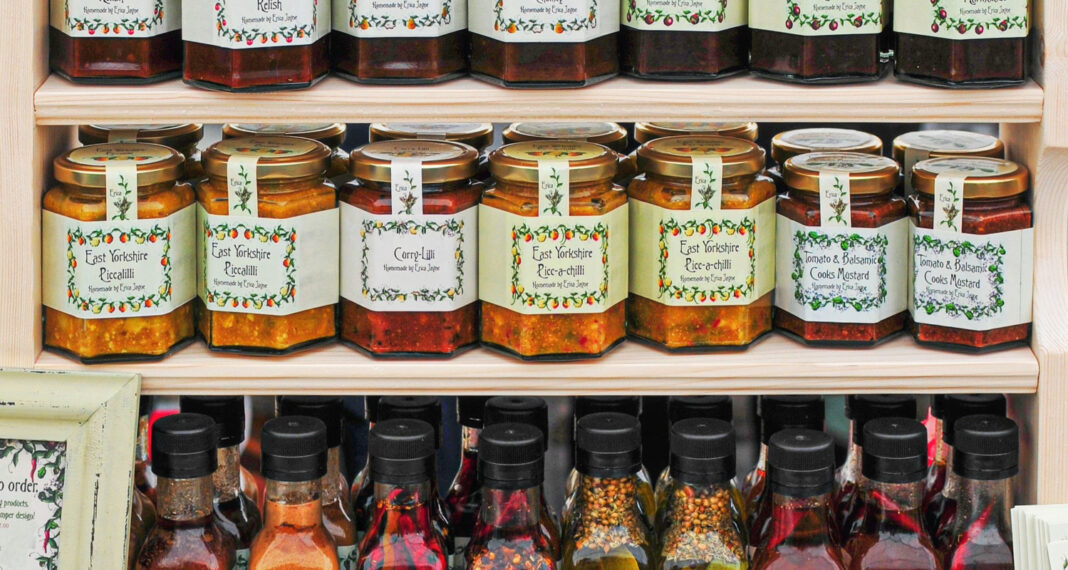Ever stood in the grocery aisle, squinting at a nutrition label, feeling a tad lost? You’re not alone! Navigating through the maze of numbers, percentages, and cryptic terms on European nutrition labels can feel like decoding a secret language. It’s frustrating, isn’t it? That tiny table on your favourite snack, meant to guide you, often ends up being a puzzle!
Navigating European nutrition labels becomes a breeze when you understand the key components: Reference Intakes, nutritional information per 100g/ml, and allergen highlights, empowering you to make informed, healthy choices effortlessly.
But what if understanding it was the key to unlocking healthier choices? Imagine the power of confidently tossing items into your cart, fully aware of the secrets they hold inside! The good news? Your guide to cracking the code of European nutrition labels is right here, turning that grocery aisle confusion into a victorious, informed shopping spree!
See Also: How to Create Nutrition Facts Label: DIY Guide
Contents
- 1 Section 1: The Essence of Nutrition Labels
- 2 Section 2: Deciphering the Nutritional Information
- 3 Section 3: Reference Intakes (RIs) Explained
- 4 Section 4: Allergen Information on Labels
- 5 Section 5: Understanding Front-of-Pack and Back-of-Pack Labelling
- 6 Section 6: US vs. EU Labeling Systems
- 7 Section 7: Practical Guide to Using Nutrition Labels for Dietary Choices
- 8 Section 8: Challenges and Solutions in Food Labeling
- 9 Section 9: Future of Food Labeling
- 10 FAQs
- 10.1 What information is included in a UK/EU nutrition label?
- 10.2 How is nutritional information calculated per serving size?
- 10.3 How does cooked vs. uncooked ingredient weight affect nutritional information?
- 10.4 What is the difference between sodium and salt in nutrition labels?
- 10.5 Are there visual systems to help understand nutritional content in food labels?
- 11 Conclusion
Section 1: The Essence of Nutrition Labels
Navigating the grocery store can be akin to wandering through a forest of choices. Each product whispers promises of flavour, nutrition, and quality. But how do we discern the genuine from the misleading? Enter the hero of our story: Nutrition Labels.
Imagine holding the power to peer into every product and unveil its nutritional secrets. European food labels grant us this superpower. They’re not just stickers on packaging but a window into the very essence of the food and drink we consume. From the energy they’ll gift us to the sugars they may stealthily carry, these labels lay it all bare, enabling us to make choices that align with our dietary desires and needs.
The Legal Shield: Regulations Around Food Labeling
In the European landscape, food labelling isn’t a mere suggestion; it’s bound by law. The EU ensures that every label serves its purpose of informing, not perplexing, the consumer. From declaring allergens to providing a clear nutritional breakdown, the legalities surrounding labels are stringent and standardized. This isn’t just bureaucracy at work; it’s a protective shield ensuring that what you see is precisely what you get.
The Unseen Impact on Dietary Choices
In the hustle of daily life, we may overlook the impact of these labels. Yet, they subtly shape our dietary choices, guiding us towards informed decisions and away from potential nutritional pitfalls.
They empower us to compare, contrast, and choose products that align with our health goals. They act as silent consultants in every food choice we make.
In this realm of transparency and choice, nutrition labels stand tall as beacons of clarity. They guide us through the dense forest of food products with assurance and reliability. And as we delve deeper into their world, we’ll uncover more of their secrets. This ensures that every choice we make is a step towards our nutritional goals.
See Also: How to Become a Nutrition Response Testing Practitioner: A Detailed Guide
Section 2: Deciphering the Nutritional Information
Embarking on a journey through the aisles of a supermarket, we’re often greeted by a myriad of choices. Each product whispers tales of flavour, nutrition, and culinary adventures. But to truly understand these tales, to dive deeper into the essence of what each product brings to our table, we must become fluent in the language of nutritional information.
Unveiling the Nutritional Tapestry
Every nutrition label adorning food products is a tapestry intricately woven with threads of vital information. It tells stories of energy, depicted in calories (kcal) and kilojoules (kJ), guiding us through the paths of our daily energy intake.
It speaks of fats, both total and saturated, whispering tales of heart health and savoury indulgences. Carbohydrates and sugars, the energetic and sometimes mischievous sprites of our nutritional journey, find their place in this tapestry, too. They offer sweetness and vitality in measured doses.
The Subtle Art of Energy Balance
Energy, often the first stop on our label-reading journey, is more than just a number. It’s a balancing act, a subtle dance between intake and expenditure, ensuring that the vitality we derive from our foods harmonizes with our daily activities.
Understanding the energy a product provides is the first step in maintaining this delicate balance. It ensures our choices fuel our adventures without tipping the scales of dietary equilibrium.
Fats: The Unsung Heroes and Hidden Villains
Fats, often misunderstood, play dual roles in our nutritional saga. They can be heroes, providing essential fatty acids and aiding in the absorption of vitamins.
But tread cautiously because they can also act as hidden villains when consumed in excess, especially the saturated kinds. They whisper tales of cholesterol and heart woes.
Carbohydrates and Sugars: The Energetic Companions
Carbohydrates, the energetic companions on our dietary journey, and sugars, their sweet-talking counterparts, bring zest and vitality to our meals. Yet, understanding their presence in our foods and distinguishing the natural from the added sugars becomes pivotal in navigating through the sweet and savoury paths of our culinary adventures.
Lastly, salt, often silently steering our flavour experiences, demands our attention. It enhances, preserves, and sometimes silently nudges our blood pressure on unnoticed trails.
Understanding its presence is key to maintaining a harmonious journey where flavours and health sail smoothly on the dietary seas. In this intricate tapestry of nutritional information, every thread, every number, and every term guides us. It allows us to navigate through the myriad of choices with informed confidence, ensuring that every product we choose aligns with the nutritional paths we wish to tread.
See Also: How Nutrition Works: A Beginner’s Guide to Understanding
Section 3: Reference Intakes (RIs) Explained
Navigating through the nutritional seascape, Reference Intakes (RIs) emerge as our compass, providing direction amidst the abundant choices and varied nutritional landscapes we encounter. But what exactly are RIs, and how do they sculpt our daily dietary journey?
The Guiding Beacon: Understanding RIs on an EU Nutrition Label
Reference Intakes, often encountered on an EU nutrition label, are not arbitrary numbers. They are meticulously crafted guidelines designed to illuminate our path towards balanced nutrition.
They encapsulate the advised maximum amounts of energy and nutrients we should consume daily, ensuring our journey is neither deficient nor excessive but just right. RIs encompass various nutrients, including energy, fat, saturated fat, carbohydrates, sugars, protein, and salt, each playing a pivotal role in our nutritional narrative.
Balancing the Nutritional Scales with RIs
RIs serve as a balancing scale, aiding us in aligning our daily intake with nutritional adequacy and vitality. They whisper gentle reminders of moderation, ensuring that our sails are set towards varied and balanced shores, preventing the winds of excess or scarcity from steering our journey astray.
For instance, when we encounter sugars, RIs guide us, ensuring that the sweetness does not sway our journey towards unhealthy realms. Similarly, fats and salts ensure our culinary adventures do not unknowingly navigate into turbulent health waters.
Crafting Daily Tales with RIs
Every food choice we make is a stitch in the tapestry of our daily nutritional intake. RIs ensure that each stitch is in harmony, crafting a daily tale that resonates with vitality, balance, and nutritional wellness. They enable us to weave our dietary stories with threads of informed choices, ensuring that the tapestry reflects not just our culinary desires but also our nutritional needs.
In the grand voyage of dietary choices, RIs stand tall as our guiding lighthouse, ensuring that every choice, every bite, and every sip, is a step towards nutritional balance and wellness, crafting daily tales where health and flavour sail hand in hand.
Section 4: Allergen Information on Labels
Embarking further into the realm of food labels, a critical beacon that demands our attention is allergen information. This isn’t merely a list but a crucial guide, ensuring the safety of those navigating through dietary restrictions and allergies.
Safeguarding Dietary Choices: Allergen Information on Nutrition Label UK
Embarking further into the realm of nutrition label UK, a critical beacon that demands our attention is allergen information. This isn’t merely a list but a crucial guide, ensuring the safety of those navigating through dietary restrictions and allergies. The labelling often bolds, italicizes, or underlines ingredients that are common allergens, ensuring they stand out in the sea of information and signal caution to those for whom these ingredients are adversaries, ensuring safe passage through the aisles of choices.
A Shield of Safety: The Imperative of Clear Allergen Information
The clarity and prominence of allergen information act as a shield, safeguarding individuals from unintended dietary misadventures. It is not merely a list but a protective barrier, ensuring that every bite taken is flavorful and safe. For those navigating the seas of food allergies, this information is not just data; it is a safeguard against potential health perils, ensuring that an unseen ingredient does not unexpectedly halt their journey.
In the vast ocean of food choices, allergen information is a vigilant sentinel, ensuring that our culinary adventures are delightful but also safe and informed. It ensures that the unseen ingredients do not steer our health off course, providing a safe, informed, and delightful journey through the world of culinary choices.
See Also: How Much Does Precision Nutrition Coaching Cost? Full Details
Section 5: Understanding Front-of-Pack and Back-of-Pack Labelling
In the vibrant marketplace of food and beverages, labels serve as our immediate touchpoint, whispering tales of what lies within. The front-of-pack (FOP) and back-of-pack (BOP) labels each tell a different chapter of the story, guiding consumers through a journey of informed choices.
In the vibrant marketplace of food and beverages, UK nutrition labels serve as our immediate touchpoint, whispering tales of what lies within. The front-of-pack (FOP) and back-of-pack (BOP) labels each tell a different chapter of the story, guiding consumers through a journey of informed choices. Particularly, the UK’s traffic light system on FOP labels provides a quick, intuitive understanding. The BOP labels offer a comprehensive breakdown for those seeking to delve deeper into their nutritional journey.
The Deep Dive: Back-of-Pack Labelling
Conversely, BOP labelling invites consumers into a deeper dialogue. It unfolds the full nutritional tapestry, detailing every nutrient, its quantity, and its role in the daily diet. It’s the detailed script, revealing the entirety of the nutritional plot, from energy values to the minutiae of micronutrients, ensuring consumers can craft their dietary tales with precision and understanding.
Navigating between FOP and BOP becomes a balancing act, where the immediate insights from FOP labels and the detailed revelations from BOP labels converge to inform and guide. The traffic light system on FOP labels provides a quick, intuitive understanding, while the BOP labels offer a comprehensive breakdown for those seeking to delve deeper into their nutritional journey.
In the culinary theatre of choices, FOP and BOP labels play pivotal roles, guiding, informing, and ensuring that every choice made is not merely a delight to the palate but also a harmonious fit into the narrative of balanced, informed nutrition. Together, they ensure that the journey through the aisles is both delightful and aligned with our nutritional scripts.
Section 6: US vs. EU Labeling Systems
Navigating the global aisles of food labelling, we encounter varied tales of nutritional information, each region narrating its story through unique labelling systems. The US and the EU, two dominant players in the global market, present their nutritional narratives through distinct labelling systems, each with its nuances, strengths, and challenges.
A Tale of Two Systems: UK Nutrition Label vs US Labeling Narrative
The US food labelling system, governed by the FDA, unfolds its nutritional tales with a focus on total caloric intake, emphasizing aspects like serving sizes and daily values based on a 2,000-calorie diet. In contrast, the UK nutrition label, under the EU labelling system, narrates a slightly different tale, emphasizing per 100g/ml nutritional information and often integrating additional voluntary labelling systems, like the traffic light system, providing an additional layer of quick, intuitive understanding to the detailed nutritional script.
In contrast, the EU labelling system, harmonized across member states, narrates a slightly different tale. It emphasizes 100g/ml nutritional information, ensuring comparability across products. The EU also often integrates additional voluntary labelling systems, like the UK’s traffic light system, providing an additional layer of quick, intuitive understanding of the detailed nutritional script.
Converging Tales: Impact on Consumer Understanding
While both systems aim to inform and guide, their impact on consumer understanding can vary. The US system, with its focus on daily values and serving sizes, may guide consumers towards understanding their intake in the context of a whole day. Meanwhile, the EU system, with its per 100g/ml approach and additional voluntary systems, might offer easier product comparability and at-a-glance understanding.
In the global marketplace, understanding these varied labelling narratives becomes pivotal. It ensures that as consumers, our dietary choices are informed, balanced, and in harmony with our nutritional needs, regardless of where our food tales originate.
See Also: How Much Does Nutrition Response Testing Cost? An Overview
Section 7: Practical Guide to Using Nutrition Labels for Dietary Choices
Embarking on a journey through the culinary landscape, nutrition labels serve as our map, guiding us through a terrain rich with choices, flavours, and nutritional pathways. But how do we translate this map into a journey that aligns with our dietary aspirations and health goals? Let’s navigate through a practical guide to using nutrition labels effectively.
Charting the Course: Actionable Tips for Using Nutrition Labels
- Deciphering the Nutritional Tapestry: Begin by understanding each element on the label – from energy to macronutrients, ensuring clarity in what each number signifies in your dietary journey.
- Navigating Through Serving Sizes: Pay attention to the serving sizes and compare them with your actual consumption to ensure your journey is accurately mapped.
- Steering Clear of Nutritional Pitfalls: Use the labels to identify and steer clear of potential nutritional pitfalls, such as high sugars, saturated fats, and salts, ensuring a smooth sail towards your health goals.
- Embarking on a Balanced Journey: Ensure that the choices made using labels align with a balanced, varied diet, ensuring each product chosen fits harmoniously into your overall dietary narrative.
Whole Foods and the Culinary Voyage
While labels guide us through processed foods, let’s not forget the territories of whole foods, rich in nutrition and devoid of labels. Fruits, vegetables, legumes, and grains each bring to the table a wealth of nutrients, flavours, and textures, enriching our dietary tales.
Weaving the Tale of Overall Dietary Patterns
Using nutrition labels effectively also means weaving them into a broader tapestry of overall dietary patterns. It’s about ensuring that the labelled products chosen complement the unlabeled, natural foods, crafting a dietary tale that is not just informed but also varies, balances, and is rich in all nutritional realms.
In the grand saga of dietary choices, nutrition labels and whole foods come together to craft tales of healthful, delightful eating. By navigating through labels and embracing the natural, unlabeled bounty of whole foods, we ensure our dietary journey is not just informed. It is also vibrant, varied, and wholesomely nourishing.
See Also: How Much Does Integrative Nutrition Cost? A Detailed Look
Section 8: Challenges and Solutions in Food Labeling
In the intricate world of food labelling, manufacturers and regulatory bodies navigate through a labyrinth of challenges and complexities, each seeking to balance regulatory compliance, consumer understanding, and practical implementation. Let’s delve into the challenges and potential solutions in the realm of food labelling.
Manufacturers often sail through seas of varied labelling requirements, each region with its regulatory islands and consumer expectations. This diversity can create a complex navigation path, where ensuring consistency, compliance, and clarity becomes a challenging voyage. It’s across different markets that manufacturers must weave through a tapestry that is both compliant and consumer-friendly. From varied nutrient reference values to different labelling formats, the journey requires careful navigation across diverse terrains.
Crafting Solutions: Best Practices in Food Labeling
- Harmonizing Regulatory Frameworks: Establishing a harmonized regulatory framework can smoothen the navigation for manufacturers. It ensures labelling requirements are standardised across regions, ensuring consistency and compliance.
- Enhancing Consumer Understanding: Implementing labelling systems that consumers intuitively understand serves their primary purpose of informing and guiding. It ensures labels are not just compliant but also consumer-friendly.
- Leveraging Technology: Employing technology, like QR codes or apps, ensures labels are concise yet comprehensive. It provides additional, personalized information to consumers.
- Engaging in Transparent Communication: Ensuring that labels communicate transparently and authentically with consumers is pivotal. It builds trust and ensures that the information provided is perceived as credible and reliable.
In the complex landscape of food labelling, crafting solutions becomes pivotal. They balance regulatory compliance, consumer understanding, and practicality. Manufacturers and regulatory bodies can ensure that labels continue to guide, inform, and protect consumers in their dietary journeys by harmonizing regulations, leveraging technology, and communicating transparently.
Section 9: Future of Food Labeling
As we gaze into the horizon of food labelling, a dynamic future unfolds, brimming with innovations, trends, and evolving narratives, each with the potential to reshape how we interact with our food.
Innovations and Trends on the Horizon
The future holds a digital transformation for food labelling, with technologies like blockchain and smart labels offering enhanced traceability and transparency. Augmented Reality (AR) might weave immersive, informative experiences. Personalized nutrition labels could tailor information to individual dietary needs and preferences.
Impacting the Landscape: Consumers and Manufacturers
These innovations promise enriched consumer experiences, offering deeper insights and personalized interactions with their food. For manufacturers, these trends offer enhanced communication channels. They also bring challenges in technology adoption, data management, and ensuring privacy and security in digital interactions.
See Also: How Much Does Blueprint Nutrition Cost? Pricing Breakdown
FAQs
What information is included in a UK/EU nutrition label?
UK/EU nutrition labels typically include total energy value (in kilojoules and kilocalories), fat (with saturated fats specified), carbohydrates, sugars, protein, and salt. All figures, except total energy value, are listed in grams. Additional optional information can include types of fats, polyols, starch, fibre, and vitamin and mineral content.
How is nutritional information calculated per serving size?
Nutritional information can be calculated per serving size, which is determined by the manufacturer and can vary between brands. For example, a chocolate bar may be divided into several servings per package. It’s essential to compare serving size information with actual consumption for accurate dietary tracking.
How does cooked vs. uncooked ingredient weight affect nutritional information?
Nutritional information can be based on either cooked or uncooked ingredient weight, affecting the accuracy of dietary tracking. For instance, pasta and meat change weight when cooked. Accurate intake calculation requires weighing food and using per 100g/ml nutritional information for precise dietary tracking.
What is the difference between sodium and salt in nutrition labels?
Sodium is a mineral found in foods, while salt (sodium chloride) is often added for seasoning. Sodium helps regulate various body functions, but excessive salt intake can pose health risks. Total salt content is calculated by considering all sodium sources in the product, not just added table salt.
Are there visual systems to help understand nutritional content in food labels?
Yes, some regions use visual systems to simplify nutritional content understanding. The UK uses a ‘traffic light’ system, indicating whether product calories, salt, sugar, and fat content are high (red), medium (orange), or low (green). Meanwhile, some EU countries use a Nutri-Score, providing an overall healthfulness rating.
Conclusion
Embarking back through the realms of nutrition labels, we’ve navigated through the intricate tapestries of information. We’ve also explored the regulatory landscapes and the potential futures unfolding in the labelling narratives. These labels, in their varied forms and evolutions, stand as silent guides. They steer our dietary journeys towards informed, balanced, and healthful shores. As we sail forward, let these labels be our compass. They guide us through the seas of dietary choices. Their goal is to impart knowledge and empowerment. They possess a sharp perception of a forthcoming era where our bond with food is not merely informed. It is additionally enriched, personalized, and intricately interlaced into our nutritional narratives.

Dr. Karen Gill is an ABMS board certified pediatrician whose expertise includes breastfeeding, nutrition, obesity prevention, and childhood sleep and behavior issues. She currently lives and practices in Portland, Oregon, where she also volunteers for CASA for Children and the Red Cross.







